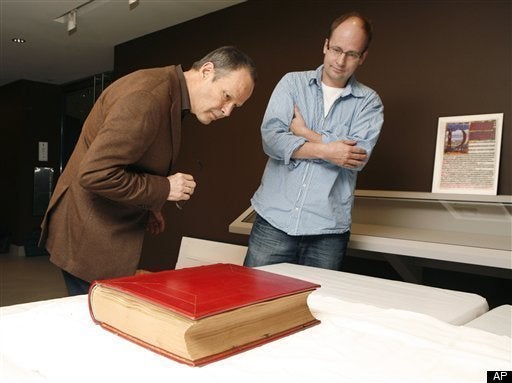
"My soul, where are you? Do you hear me? I speak, I call you----are you there?"
Don't these simple questions somehow resonate deeply? Aren't they timeless, evergreen, universal?
These poetic lines were written by Carl Jung, the renowned 20th century psychologist, in a journal entry of his long-hidden diary-like work entitled The Red Book. The other day I was fortunate to see the first-ever exhibit and published translation of The Red Book at the Rubin Museum of Art in New York City. Until this exhibit, The Red Book has never before been seen in public; Jung's Swiss nuclear family apparently feared that its publication might harm Jung's reputation.
Jung often said that everything he wrote about and developed in his thought over the years-- including his principal theories of archetypes, the collective unconscious, and the process of individuation-- stemmed from a lengthy, intensely visionary period of spiritual breakdown and breakthrough before World War I. During this time, he experienced countless visions, dreams, hallucinations, and out-of-body experiences. Jung created The Red Book between 1914-1930, majestically chroniclling a multitude of these experiences, observations and oracular intimations.
The Red Book itself is a gorgeous, oversized volume bound in red leather, replete with many wonders-- all documenting this extraordinary personal psycho-spiritual journey. The Red Book completely captivates and transports its readers. Carl Jung's writing is beautiful, his calligraphy exquisite in places, and the brightly hued images are stunning. Some pages look like an illuminated manuscript or an ancient, visionary bible, while others display his visionary drawings, some of which have a mandala-like quality.
The journal entry continued:
"I have returned. I am here again.... After long years of wandering I have come home to you [my soul] again. Should I tell you everything I have seen, experienced and drunk in?"
Although he wasn't addressing these questions to me personally, as I stood reading these lines at the exhibit, I couldn't help but answer "YES!" I wanted to hear more of his journey, his intense inner exploration and spiritual evolution. The Red Book is a striking example of how seeing the light in another can help us find the light already burning gently, burning brightly inside of us. Some of the Master's multicolored drawings seem intent upon ascending from the darkened colors up into the light, as if from ignorance to wisdom and from death to immortality-- to parse lines from Mahatma Gandhi's favorite prayer, from the ancient Hindu scripture called The Upanishads. Others draw one in as if along an ever-deepening tunnel-like path, through a psychic energy vortex and into the inner maze of consciousness and the clear light of the higher spiritual mind and its recondite mysteries.
Walking through this modest-yet-potent museum exhibit of The Red Book, my friend and I couldn't help but become inspired and even a bit giddy. Reading his journal entries, I felt connected to an unusual aspect of our multi-faceted spiritual path. Looking at his drawings-- secret cryptograms of the self, as he put it-- I felt inspired to gaze reflectively upon my own original face, as zen teachers call it, and to let my own creative juices flow more freely.
In addition to being a pioneer in the field of western psychology, Jung also helped introduce Eastern thought to the Western world. I have long admired his observations in the Introductions to books I always have near at hand such as Richard Wilhelm's groundbreaking translations of the I Ching (Book of Changes), and The Secret of the Golden Flower (a classic book of ancient Chinese healing), as well as Evans-Wentz's translation of The Tibetan Book of the Dead (a vaunted Buddhist Dzogchen text about both the bardo---intermediate states between life and death---and how to awaken spiritually through recognizing such transitions in life as well as in death). In these Introductions, Jung brings the modern, psychological and Western world to bear on the perennial wisdom of the East.
Back once again to the exhibit, his journal entry continued:
"But one thing you [my soul] must know: the one thing I have learned is that one must live this life. This life is the way, the long sought-after way to the unfathomable, which we call the divine."
Here, in western words, written about 1913, is a sublime expression of Buddhist Tantra: It is through this life that we can find the unfathomable, the divine. We can find the sacred, he tells us----and as he shows us so generously in The Red Book---- if we continue on our psycho-spiritual journey and plumb our own depths.
So, let us follow in the footsteps of Jung and the Dzogchen masters and "live this life" so that we too can find the unfathomable.
If this sparks an interest, The Red Book will be on display at The Rubin
Museum in NYC until 2/15/09 (http://www.rmanyc.org). You can also buy facsimiles of The Red Book (translated by Dr. Sonu Shamdasani) on-line.
Visit Lama Surya Das' website at: www.surya.org/